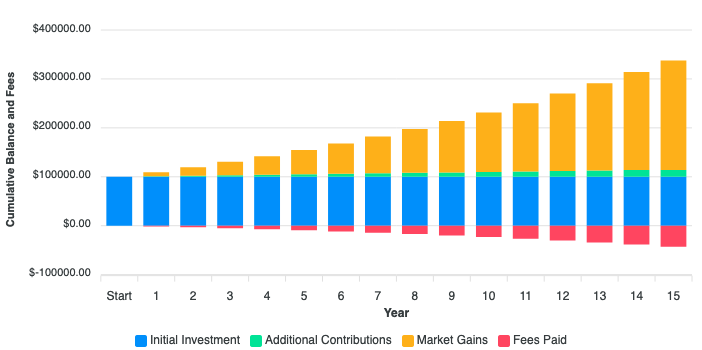On this page is an ETF or a mutual fund fee calculator with optional fee visualization. Enter details about an investment in a fund plus any management or marketing expenses and front- and back-end load costs, then enter your assumptions for future returns and new investments. The tool will then calculate how much you'll lose to fees along with your final net investment balance.
Fund Fee Calculator
Using the Mutual Fund or ETF Fee Calculator
The calculator requires you to enter a few known values about the cost of the fund and your initial investment, plus your best guess for future gains (and new investments).
Current Day Inputs
- Initial Investment: Enter how much you initially purchase of the ETF, mutual fund, or other fund on the first day (or how much you currently have invested).
- Annual Management Fee: Enter the total percentage of the fund balance lost to operating fees or marketing charges a year. This may be in the form of management expenses (the so-called MER or management expense ratio), or the total of other total quoted fees, including 12b-1 fees.
- Front End Load: If the fund charges a front-end load when you buy in, enter it here. The tool will apply the load to any additional investments over the year.
- Back End Load: Enter the total percentage here if the fund charges a back-end load when you sell. The tool will apply it in the final holding year.
Future Assumption Inputs
- Years Invested: Guess how long you'll be invested in this mutual fund, ETF, or other type of fund.
- Annual Addition: If you plan to make new contributions every year, enter the amount you're going to be adding here.
- Annual Return: Guess how much your investment will return a year, on average (well – geometric average or compound annual return). Perhaps look at the S&P 500 Return Calculator or 10 Year Treasury Return Calculator for a defensible base rate.
Outputs (and Fee Visualization)
- Net Balance: This field shows your final balance after any back-end fees are paid – but before any taxes owed, if in a taxable account.
- Market Gains: The total amount of gains that came from the value of the underlying investment appreciating.
- Initial Investment: A reminder of how much you started with in the investment.
- Additional Contribution: The amount you added in periodic investments over the years. (Note the tool assumes you don't invest in the final holding year.)
- Fees Paid: The total amount of fees paid over the years.
- Fees % of Balance: The total fees as a percentage of the net balance you have at the end of the investment. Note there's no cap here – it's possible to pay more than your final balance in funds with bad performance and fee structures.
Additionally, if you choose the "Project & Draw Graph" button, the tool will show a visualization of your investment balance over time. Hover your mouse (or tap on mobile) to see the category breakdown each year. You can show and hide categories in the legend to focus on one area (fees or market gains, perhaps).

Fees, Fees, Everywhere
Wherever you look in finance, you'll find a fee - even if it uses a fancier name! ETFs, mutual funds, and all sorts of other investment structures and funds (closed end funds, master limited partnerships, business development corporations, and so on) all charge management fees of some sort.
Intuitively, you know it's best to pay smaller fees for any given investment strategy. For access to star managers or tricky investment styles, you likely need to pay higher amounts – but for basic stock strategies such as index tracking, you benefit from looking for the funds with the lowest fees.
Fee Example – Which Mutual Fund to Pick?
Let's say you were evaluating two investments, and with both, you expect a 10% annual return.
- Investment 1: 5.75% front end load, 2% back end load, and an ongoing 1.25% expense ratio.
- Investment 2: No load with a 2% annual management fee.
If you invest $100,000 upfront, hold for 10 years, and add $5000 additional per year – which investment should you purchase?
- Investment 1: $275,557.21 as a final balance, with $37,000.27 in fees paid over time (13.43% of total balance)
- Investment 2: $278,676.13 as a final balance, with $37,703.52 in fees paid over time (13.53% of total balance)
In this case, Investment 2 is likely your better option. That's the case even though you paid more in fees – both as a percentage of your final balance and raw dollar amount.
Now, I cherry-picked this example to prove a point – it's worth it to do the math. Depending on your assumptions, the type of fees you pay (and their timing) can make a more significant difference to your returns than the total amount you lose to fees.
(And in all honesty, unless this were a very hard-to-access asset class you wanted exposure to, I'd skip them both!)
Fighting High Fees
Hopefully, this tool provides a decent illustration of how destructive fees can be to your overall investment returns. Just as with taxes, fees act as a drag on your returns – and make achieving high returns in the stock market just a little bit harder.
Luckily for us all, the fees to passively follow popular investment styles have come down as a group over time due to automation, methodology, and competition. However, there are still places you can get caught in high fee investments – beware hidden fees, and good luck investing.
Additional Resources:
